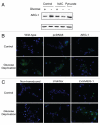Astrocyte-elevated gene-1 (AEG-1) induction by hypoxia and glucose deprivation in glioblastoma
- PMID: 21084864
- PMCID: PMC3047099
- DOI: 10.4161/cbt.11.1.13835
Astrocyte-elevated gene-1 (AEG-1) induction by hypoxia and glucose deprivation in glioblastoma
Abstract
Glioblastomas continue to carry poor prognoses for patients despite advances in surgical, chemotherapeutic, and radiation regimens. One feature of glioblastoma associated with poor prognosis is the degree of hypoxia and expression levels of hypoxia-inducible factor-1 α (HIF-1α). HIF-1α expression allows metabolic adaptation to low oxygen availability, partly through upregulation of VEGF and increased tumor angiogenesis. Here, we demonstrate an induced level of astrocyte-elevated gene-1 (AEG-1) by hypoxia in glioblastoma cells. AEG-1 has the capacity to promote anchorage-independent growth and cooperates with Ha-ras in malignant transformation. In addition, AEG-1 was recently demonstrated to serve as an oncogene and can induce angiogenesis in glioblastoma. Results from in vitro studies show that hypoxic induction of AEG-1 is dependent on HIF-1α stabilization during hypoxia and that PI3K inhibition abrogates AEG-1 induction during hypoxia through loss of HIF-1α stability. Furthermore, we show that AEG-1 is induced by glucose deprivation and that prevention of intracellular reactive oxygen species (ROS) production prevents this induction. Additionally, AEG-1 knockdown results in increased ROS production and increased glucose deprivation-induced cytotoxicity. On the other hand, AEG-1 overexpression prevents ROS production and decreases glucose deprivation-induced cytotoxicity, indicating that AEG-1 induction is necessary for cells to survive this type of cell stress. These observations link AEG-1 overexpression in glioblastoma with hypoxia and glucose deprivation, and targeting these physiological pathways may lead to therapeutic advances in the treatment of glioblastoma in the future.
Figures






Comment in
-
Astrocyte-elevated gene-1 (AEG-1): Glioblastoma's helping hand during times of hypoxia and glucose deprivation?Cancer Biol Ther. 2011 Jan 1;11(1):40-2. doi: 10.4161/cbt.11.1.14139. Epub 2011 Jan 1. Cancer Biol Ther. 2011. PMID: 21150314 No abstract available.
Similar articles
-
AEG-1 Contributes to Metastasis in Hypoxia-Related Ovarian Cancer by Modulating the HIF-1alpha/NF-kappaB/VEGF Pathway.Biomed Res Int. 2018 Mar 25;2018:3145689. doi: 10.1155/2018/3145689. eCollection 2018. Biomed Res Int. 2018. PMID: 29770329 Free PMC article.
-
Astrocyte-elevated gene-1 (AEG-1): Glioblastoma's helping hand during times of hypoxia and glucose deprivation?Cancer Biol Ther. 2011 Jan 1;11(1):40-2. doi: 10.4161/cbt.11.1.14139. Epub 2011 Jan 1. Cancer Biol Ther. 2011. PMID: 21150314 No abstract available.
-
HIF-1α binding to AEG-1 promoter induced upregulated AEG-1 expression associated with metastasis in ovarian cancer.Cancer Med. 2017 May;6(5):1072-1081. doi: 10.1002/cam4.1053. Epub 2017 Apr 12. Cancer Med. 2017. PMID: 28401704 Free PMC article.
-
Astrocyte elevated gene-1: recent insights into a novel gene involved in tumor progression, metastasis and neurodegeneration.Pharmacol Ther. 2007 May;114(2):155-70. doi: 10.1016/j.pharmthera.2007.01.010. Epub 2007 Feb 24. Pharmacol Ther. 2007. PMID: 17397930 Free PMC article. Review.
-
Astrocyte elevated gene-1 as a novel therapeutic target in malignant gliomas and its interactions with oncogenes and tumor suppressor genes.Brain Res. 2020 Nov 15;1747:147034. doi: 10.1016/j.brainres.2020.147034. Epub 2020 Jul 31. Brain Res. 2020. PMID: 32745657 Review.
Cited by
-
AEG-1/MTDH/LYRIC: signaling pathways, downstream genes, interacting proteins, and regulation of tumor angiogenesis.Adv Cancer Res. 2013;120:75-111. doi: 10.1016/B978-0-12-401676-7.00003-6. Adv Cancer Res. 2013. PMID: 23889988 Free PMC article.
-
Downregulation of astrocyte elevated gene-1 expression inhibits the development of vasculogenic mimicry in gliomas.Exp Ther Med. 2021 Jan;21(1):22. doi: 10.3892/etm.2020.9454. Epub 2020 Nov 6. Exp Ther Med. 2021. PMID: 33235631 Free PMC article.
-
The role of AEG-1/MTDH/LYRIC in the pathogenesis of central nervous system disease.Adv Cancer Res. 2013;120:159-92. doi: 10.1016/B978-0-12-401676-7.00006-1. Adv Cancer Res. 2013. PMID: 23889991 Free PMC article. Review.
-
Crucial Role of RLIP76 in Promoting Glycolysis and Tumorigenesis by Stabilization of HIF-1α in Glioma Cells Under Hypoxia.Mol Neurobiol. 2022 Nov;59(11):6724-6739. doi: 10.1007/s12035-022-02999-w. Epub 2022 Aug 23. Mol Neurobiol. 2022. PMID: 35998001
-
Phenethyl Isothiocyanate Suppresses Stemness in the Chemo- and Radio-Resistant Triple-Negative Breast Cancer Cell Line MDA-MB-231/IR Via Downregulation of Metadherin.Cancers (Basel). 2020 Jan 22;12(2):268. doi: 10.3390/cancers12020268. Cancers (Basel). 2020. PMID: 31979093 Free PMC article.
References
-
- Oliver L, Olivier C, Marhuenda FB, Campone M, Vallette FM. Hypoxia and the malignant glioma microenvironment: regulation and implications for therapy. Curr Mol Pharmacol. 2009;2:263–284. - PubMed
-
- Kang DC, Su ZZ, Sarkar D, Emdad L, Volsky DJ, Fisher PB. Cloning and characterization of HIV-1-inducible astrocyte elevated gene-1, AEG-1. Gene. 2005;353:8–15. - PubMed
-
- Yu C, Chen K, Zheng H, Guo X, Jia W, Li M, et al. Overexpression of astrocyte elevated gene-1 (AEG-1) is associated with esophageal squamous cell carcinoma (ESCC) progression and pathogenesis. Carcinogenesis. 2009;30:894–901. - PubMed
Publication types
MeSH terms
Substances
LinkOut - more resources
Full Text Sources
Research Materials
